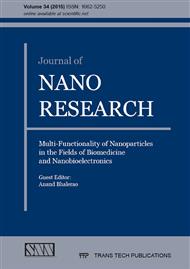p.29
p.41
p.49
p.61
p.67
p.73
p.79
p.91
p.99
Study of Structural, Surface Morphological and Dielectric Properties of Cu-Doped Tin Oxide Nanoparticles
Abstract:
Cu doped SnO2 nanoparticles were prepared using the chemical precipitation method. The Cu doped SnO2 nanoparticles have been characterized by powder X-ray diffraction (XRD) analysis, Scanning electron microscopy (SEM), elemental dispersive X-ray (EDX) analysis, Transmission electron microscopy (TEM), UV-Visible absorption spectrum and Dielectric studies. The average crystalline size of Cu doped SnO2 nanoparticles was calculated from the X-ray diffraction (XRD) pattern and found to be 15 nm and it was further confirmed from the transmission electron microscopy (TEM) studies. The scanning electron microscopy (SEM) analysis showed that the nanoparticles agglomerate forming spherical-shaped particles. The elemental composition of Cu doped SnO2 nanoparticles was analyzed by Energy Dispersive X-ray (EDX) spectrum. The optical absorption study clearly shows that the absorption edge shift towards the higher wavelength region. The dielectric properties of Cu doped SnO2 nanoparticles have been studied in the different frequency at different temperatures. The dielectric constant and dielectric loss of the Cu doped SnO2 nanoparticles decreases with increase in frequency. Cu doped SnO2 nanoparticles were prepared using the chemical precipitation method. The Cu doped SnO2 nanoparticles have been characterized by powder X-ray diffraction (XRD) analysis, Scanning electron microscopy (SEM), elemental dispersive X-ray (EDX) analysis, Transmission electron microscopy (TEM), UV-Visible absorption spectrum and Dielectric studies. The average crystalline size of Cu doped SnO2 nanoparticles was calculated from the X-ray diffraction (XRD) pattern and found to be 15 nm and it was further confirmed from the transmission electron microscopy (TEM) studies. The scanning electron microscopy (SEM) analysis showed that the nanoparticles agglomerate forming spherical-shaped particles. The elemental composition of Cu doped SnO2 nanoparticles was analyzed by Energy Dispersive X-ray (EDX) spectrum. The optical absorption study clearly shows that the absorption edge shift towards the higher wavelength region. The dielectric properties of Cu doped SnO2 nanoparticles have been studied in the different frequency at different temperatures. The dielectric constant and dielectric loss of the Cu doped SnO2 nanoparticles decreases with increase in frequency.
Info:
Periodical:
Pages:
91-97
Citation:
Online since:
July 2015
Authors:
Price:
Сopyright:
© 2015 Trans Tech Publications Ltd. All Rights Reserved
Share:
Citation:


